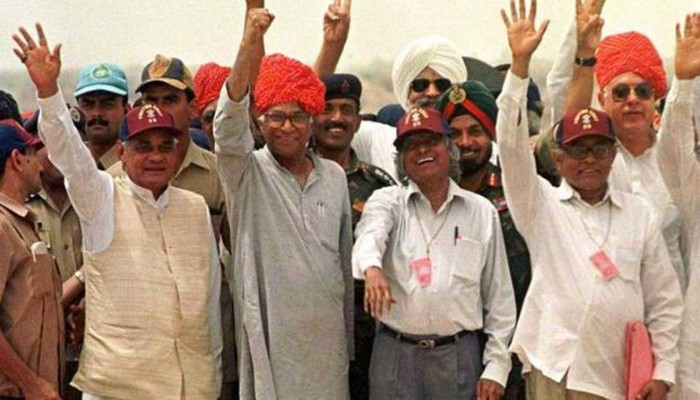Pokhran ll: How India Outwitted US spy satellites
- In Reports
- 12:21 PM, Jan 01, 2021
- Myind Staff
India completed more than 22 year of its journey as a nuclear power. In 1998, India secretly conducted a series of underground nuclear tests in Pokhran, Rajasthan under the leadership of then Prime Minister Atal Bihari Vajpayee.
Although this was not the first time the country was testing its nuclear weapons but this one was certainly the most memorable as it had really shook the world. The first successful Nuclear test took place on 18th of May 1974 under the leadership of then Prime Minister Indira Gandhi with the codename “Smiling Buddha.” It was described by India as a "peaceful nuclear explosion", in Pokhran.
Things changed in the 1980s when Pakistan began to covertly develop its own nuclear program. India was then forced to develop its own program undercover.
After 24 years, Pokhran 2 nuclear test was conducted under the codename operation Shakti on 11th of May in 1998. The landmark event took place on the hottest day of the year when rest of the world was sleeping India entered into nuclear era.
The tests consisted of 5 detonations, one fusion and two fission bombs were tested on May 11, and two more fission bombs on May 13. Shortly after the detonation of all five warheads, the then Prime Minister Atal Bihari Vajpayee declared India a full-fledged nuclear state.
How it all started?
In March 1998 Atal Bihari Vajpayee once again became the Prime Minister of India with a vision to develop India's own Nuclear weapons
On April 8, Department of Atomic Energy chief R Chidambaram and Defence Research and Development Organisation chief APJ Abdul Kalam were summoned and given thumbs up for the tests.
The operation was conducted in such high secrecy that nobody except the then Home minister LK Advani knew about it. Even Defence minister George Fernandes was told about the tests on 9th May.
Vajpayee and his principal secretary Brajesh Mishra controlled the entire operation from the Prime Minister’s Office.
How it was kept a secret from US Satellites?
The Indian Intelligence Agency was aware of United States spy satellites and the CIA detecting Indian test preparations since 1995. Therefore, the tests required complete secrecy in India and also needed to avoid detection by other countries.
The 58th Engineer Regiment of the Indian Army Corps of Engineers was commissioned to prepare the test sites to avoid detection.
The scientists and engineers of the Bhabha Atomic Research Centre (BARC), the Atomic Minerals Directorate for Exploration and Research (AMDER), and the Defence Research and Development Organisation (DRDO) were involved in the nuclear weapon assembly, layout, detonation and data collection.
Work was mostly done during night, and equipment was returned to the original place to give an impression that it was never moved.
Scientists would not depart for Pokhran in groups of two or three.Technical staff at the test range wore military uniforms, to prevent detection by satellite images.
It is a well-documented fact that satellites worth billions were used to spy on Pokhran at all times.
In fact, there were four satellites that were so technologically advanced that they could supposedly even be used to count the number of green patches the Indian Army soldiers had on their fatigues.
And all India had against them were the “Regiment 58 Engineers” from the Indian Army.
Every move was meticulously planned and formulated. The forces had thought through every aspect of the mission.
False names were provided to scientists. APJ Abdul Kalam’s name was switched with Major General Prithvi Raj and Rajagopala Chidambaram’s codename was “Natraj”.
As for the CIA, they were unaware that the tests had taken place until Vajpayee declared the feat that India had accomplished on television.
After the Nuclear test, US senator Richard Shelby articulated that the CIA’s failure to identify that these tests were going to take place was "the biggest failure of our intelligence gathering agencies in the past ten years or more”.
The Clinton Administration was left furious. It condemned the tests and said it was “deeply disappointed” and subsequently slapped sanctions against India. Britain conveyed its “dismay” and Germany called it “a slap in the face” for the countries that ratified CTBT and the then-UN secretary general Kofi Annan issued a statement expressing his “deep regret”.
The US imposed economic sanctions, while some European nations and Japan halted aid. Pakistan responded with its own atomic blasts two weeks later, ignoring appeals from world leaders to show restraint.
Inspite of all the criticism and sanctions, Vajpayee had an answer for everyone and over the years, the world have also acknowledged India’s success in conducting the tests.
For India, testing a nuclear weapon was also necessaryto pursue big power status. The Indian leadership, with Vajpayee at the top, felt that conducting a nuclear test was a necessity if India has to be taken seriously by the world.
The world criticised the action taken by India. But today what is is clear that India's action was not only timely but also inevitable.
India is currently among the nine countries in the world that have a publicly known nuclear weapons program.
Image Credit: Daily O







Comments